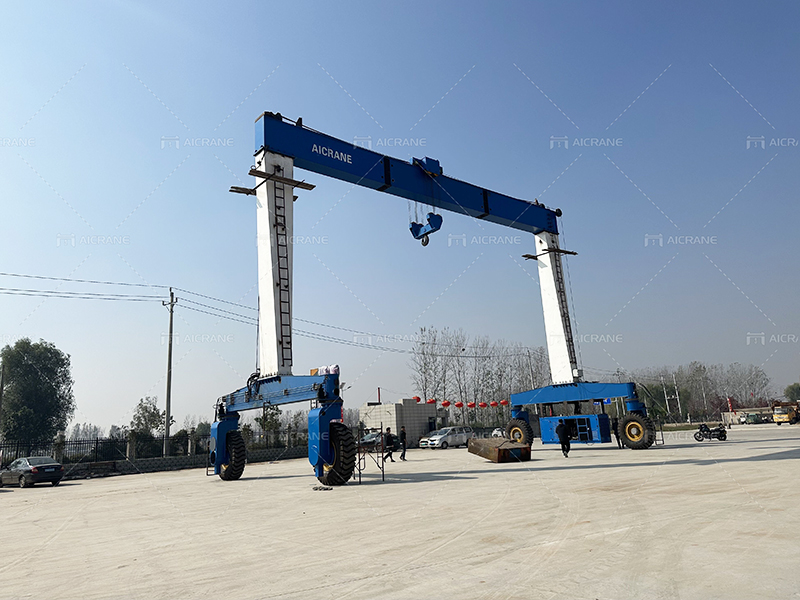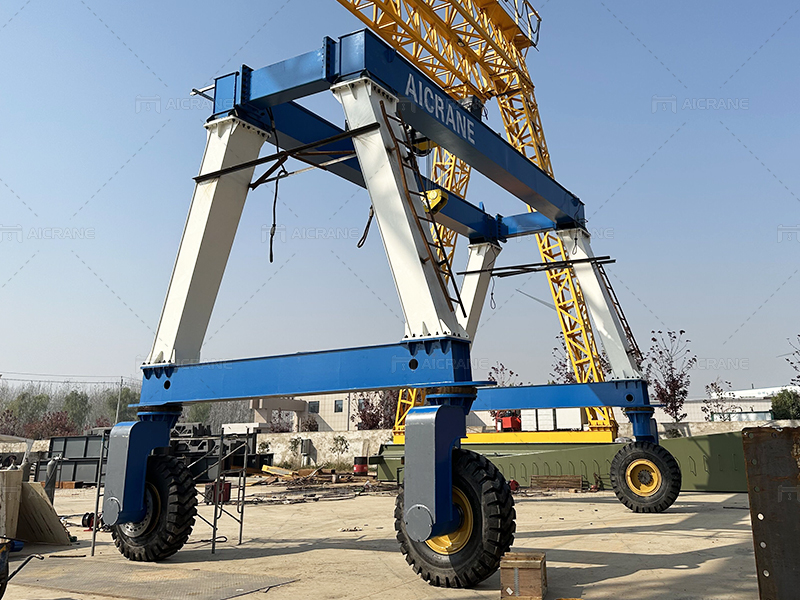Maintaining the tires of a rubber tire gantry crane is crucial for ensuring optimal performance, safety, and longevity of the equipment. These tires bear the weight of the crane and the loads it lifts, moves, and transports, making them critical components that require regular maintenance and care. Proper tire maintenance not only enhances crane efficiency but also reduces downtime, extends tire life, and minimizes operating costs. In this comprehensive guide, we will explore the best practices for maintaining tires on a rubber tire gantry crane.

Regular Inspection
The first step in tire maintenance is conducting regular inspections to assess tire condition of the gantry crane, tread wear, inflation levels, and overall integrity. Here are the key aspects to focus on during inspections:
Tread Wear: Check the tire tread depth using a tread depth gauge. Monitor tread wear patterns for signs of uneven wear, bald spots, or cupping, which may indicate alignment issues or improper inflation.
Inflation Pressure: Use a tire pressure gauge to measure inflation pressure. Maintain inflation levels according to the manufacturer’s recommendations, as under-inflated or over-inflated tires can lead to premature wear, reduced stability, and decreased fuel efficiency.
Tire Damage: Inspect tires for cuts, punctures, cracks, bulges, and other damage. Check the sidewalls and tread surface thoroughly for any signs of wear or deterioration.
Valve Stems: Ensure valve stems are intact, properly seated, and free from leaks. Replace damaged or leaking valve stems promptly to maintain optimal tire pressure.
Wheel Alignment: Monitor wheel alignment regularly to prevent excessive tire wear and improve steering control. Misaligned wheels can cause rapid tire wear on specific areas and affect crane stability.
Suspension Components: Check suspension components, including shock absorbers, springs, and linkage systems, for wear, leaks, or damage that may impact tire performance and ride quality.
Tire Rotation
Implement a regular tire rotation schedule to promote even wear across all tires and extend tire life. Rotate tires following a recommended pattern, typically swapping front and rear tires and left and right tires to distribute wear more evenly. Rotate tires at specified intervals based on usage, load conditions, and tire wear patterns.
Wheel Balancing
Ensure proper wheel balancing to reduce vibrations, improve ride comfort, and prevent premature tire wear. Use a dynamic wheel balancer to balance tires accurately, considering factors such as tire wear, tread patterns, and load distribution. Balance tires whenever rotating them or if vibrations are experienced during crane operation.
Maintain Proper Alignment
Proper wheel alignment is essential for optimal tire performance, steering control, and stability. Align the crane’s wheels periodically using alignment equipment and tools. Adjust toe, camber, and caster angles as per manufacturer specifications to ensure straight tracking, reduced tire scrubbing, and improved handling.
Cleanliness and Debris Removal
Keep tires clean and free from debris, mud, grease, and contaminants that can accelerate tire wear, corrosion, and damage. Regularly wash tires with mild soap and water, avoiding harsh chemicals that may degrade rubber compounds. Remove lodged debris, rocks, or foreign objects from tire treads to prevent punctures or cuts.
Proper Storage
Store spare tires and unused tires in a clean, dry, and climate-controlled environment to protect them from sunlight, moisture, temperature extremes, and chemical exposure. Use tire racks or storage racks to organize tires and prevent deformation or damage during storage.

Tire Repairs and Replacements
Address tire repairs promptly to prevent further damage and ensure safe operation. Repair minor punctures, cuts, or leaks using industry-approved tire repair kits and techniques. For significant damage, sidewall injuries, or tread wear beyond acceptable limits, replace tires with new ones that meet crane specifications.
Operator Training and Awareness
Educate crane operators and maintenance personnel on proper tire care, inspection procedures, inflation techniques, and safe handling practices. Encourage operators to report any abnormal tire conditions, vibrations, or performance issues for immediate evaluation and corrective action.
Use OEM Parts and Services
When replacing tires or performing maintenance, use genuine OEM parts, tires, and components recommended by the crane manufacturer. Follow manufacturer guidelines, service manuals, and maintenance schedules to ensure compliance, warranty coverage, and optimal performance.
Document and Track Maintenance
Maintain detailed records of tire maintenance activities, inspections, repairs, rotations, replacements, and performance metrics. Use maintenance logs, digital records, and tracking systems to monitor tire health, track service intervals, and identify trends or recurring issues for proactive management.
By following these best practices and incorporating a proactive tire maintenance program, you can optimize the performance, safety, and durability of tires on a rubber tyre gantry crane. Regular inspections, proper inflation, tire rotations, wheel balancing, alignment adjustments, cleanliness, prompt repairs, and operator training are key elements in ensuring reliable and cost-effective tire operation. Prioritize tire maintenance as part of overall crane maintenance to enhance operational efficiency, minimize downtime, and maximize tire service life.
